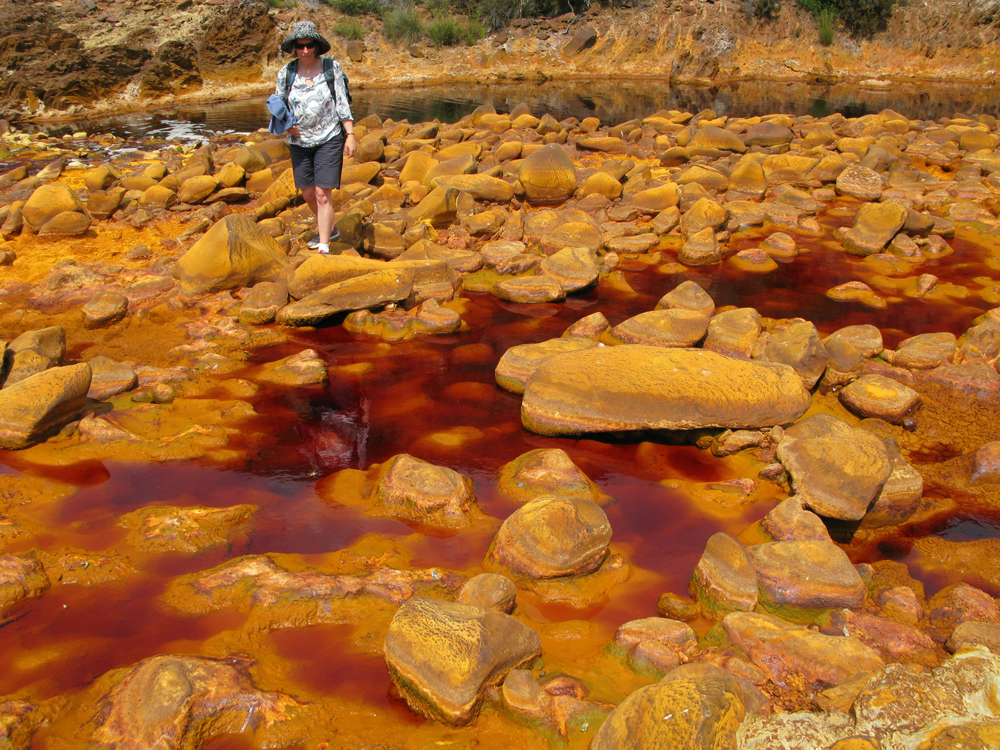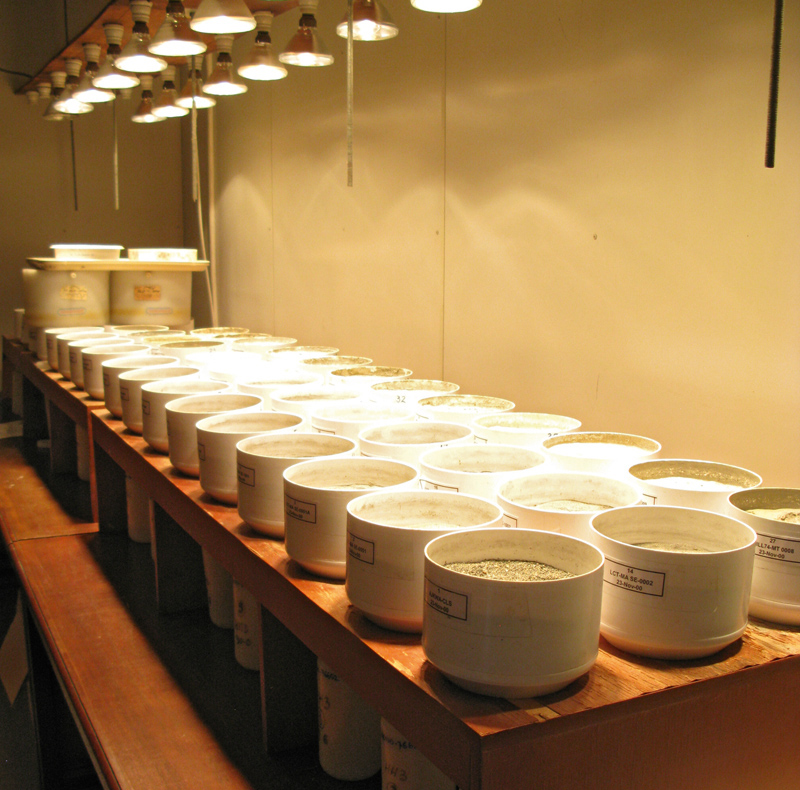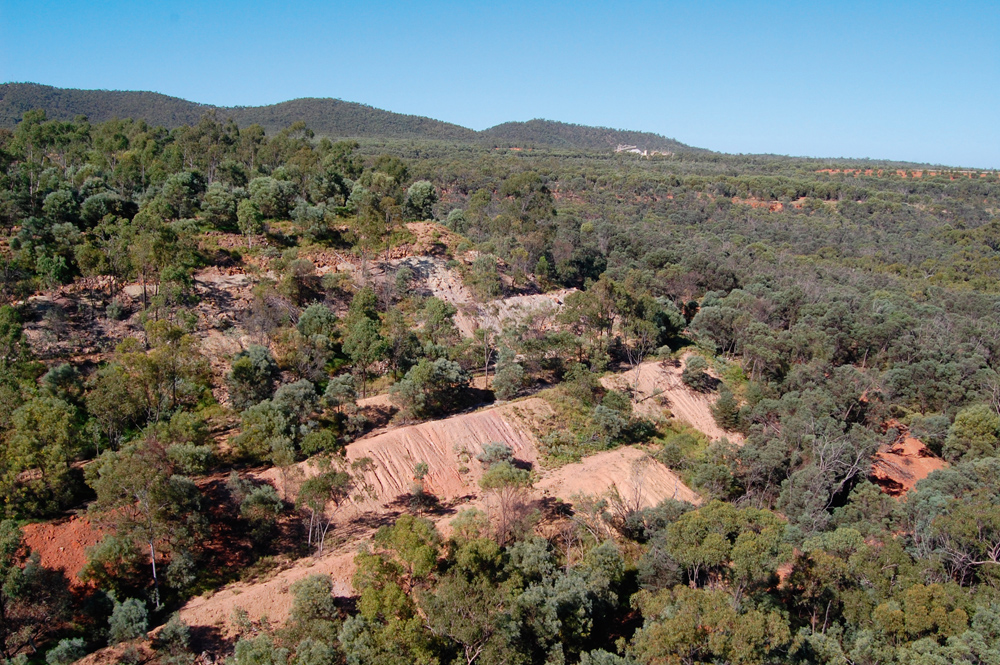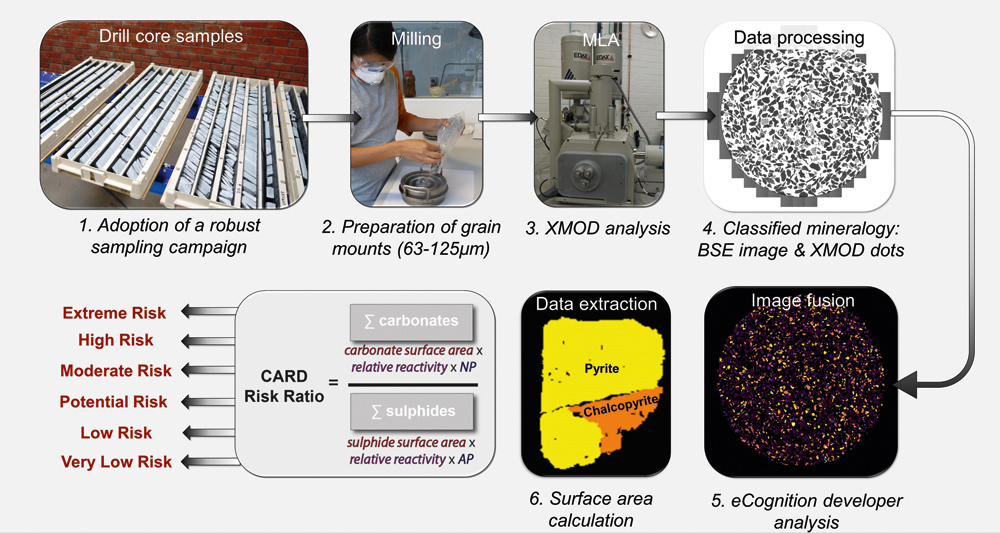Leiter des Institute of Mineral Resources Engineering,
Rheinisch Westfälische Technische Hochschule (RWTH) Aachen
1 Introduction
Today, the control and mitigation of acid mine drainage (AMD) is considered to be one of the major environmental challenges facing the mining industry worldwide (1). Likely costs for AMD mitigation in Australia, Canada, Sweden and the USA, e. g., are US-$ 300 m, US-$ 1,900 – 5,300 m, US-$ 900 m and US-$ 32,000 – 72,000 m, respectively (2). South Africa alone needs to spend as much as US-$ 1,000 m to make AMD water leaking from abandoned mine shafts drinkable (3). The estimated costs for total worldwide liability associated the current and future remediation of AMD are approximately 100,000 million US-$ (2).
Predicting the environmental risks of mineral resource development is usually not an aspect that is strongly embedded into the development of mineral deposits as other aspects such as resource evaluation and testing for beneficiation, mineral processing and recovery attributes of ores and different ore types take priority. Nevertheless, early AMD characterisation and risk assessment at the exploration, pre-feasibility and feasibility stages support more effective management of ores and wastes during mineral processing, subsequent storage of waste and ultimately improved mine closure outcomes.
Consequently, there is a growing need to provide early predictive information of intrinsic rock characteristics likely to result in AMD, which in turn impact on waste management throughout the life-of-mine phases. The objectives of this contribution are to review the approaches to AMD prediction and to illustrate our advances in knowledge and the challenges ahead.
2 Predicting acid mine drainage: Past
The spontaneous oxidation of sulfide minerals is arguably one of the most important environmental processes at many metalliferous and coal mine sites because the exposure of sulfide minerals to air and water may lead to acid production and the dissolution and mobilisation of metals and metalloids. The knowledge that sulfide minerals oxidise at the Earth’s surface and that this process causes the release of environmentally significant elements to ground and surface waters is not new to modern science. Early civilisations of Mesopotamia and Egypt as well as Greek and Roman scholars were familiar with the salts formed from pyrite oxidation (4).

Fig. 1. AMD waters in the Rio Tinto, Spain. // Bild 1. AMD-belastetes Wasser im Rio Tinto, Spanien. Photo/Foto Lottermoser
Sulfide oxidation and resultant AMD due to mining have a long history dating back thousands of years, when the Rio Tinto mining district of Spain experienced periods of intense mining during Roman times and the associated production of pyrite-rich wastes and AMD waters (Figure 1). At Rio Tinto, mining is not exclusively accountable for the generation of AMD and its impact on the river (5). Historical accounts document the river’s long-standing acidity. The Romans named the Rio Tinto ‘urbero’, Phoenician for ‘river of fire’, and the Arab name for it was ‘river of sulfuric acid’. The enormous sulfide orebodies experienced long-term deep weathering and erosion in their geological history and, acid weathering of outcropping sulfide ores produced large-scale gossans and natural AMD prior to mining (6). Thus, the river’s conditions today are a combination of natural and mining induced AMD.
The very first ground-breaking observations on AMD and the use of indicators to understand AMD processes at mine sites were documented by Diego Delgado, a 16th century priest, who inspected the Rio Tinto mines and river at the directive of Spain’s King Phillip II (7). In 1556 when Diego Delgado reported on the mines, he recognised that
- pyrite oxidation causes the formation of AMD products including sulfuric acid;
- iron dissolves in AMD waters;
- iron hydrolyses and forms iron-rich cements in stream sediments;
- AMD waters are poisonous to fish and other aquatic organisms; and
- simple tests can reveal the ecotoxicity of AMD waters (7).
In doing so, Diego Delgado became one of the first scholars, if not the first, to understand AMD formation and its impacts.
3 Predicting acid mine drainage: Present
3.1 Static and kinetic tests
Since Diego Delgado, remarkable advances in our capability to observe, describe, quantify and predict the oxidation of sulfide minerals and AMD formation have been achieved. In the 1960s, qualitative observations were made between lithology and leachate and these correlations were used to forecast waste properties. In the 1970s, geochemical testing was introduced, based on static and kinetic testwork. To date, much of the industry still utilises these geochemical tests established in the 1970s and, the scientific literature is packed with studies on sulfide oxidation as well as the chemical reactions and processes leading to AMD development. There is a detailed understanding of the weathering reactions that cause sulfide oxidation and AMD development, and numerous quantitative tests have been designed to predict AMD risks and waste properties. Such methods range from static laboratory-based methods to long-term kinetic trials.
The mining industry prefers static chemical testing to predict AMD risks as they are offered as defined analytical packages by commercial laboratories. Numerous static tests have been developed but all of them are rapid (usually measured in hours and days), low-cost screening tests to evaluate samples for their net acid potential (8, 9). The most widely used static methods quantitatively balance the acid generated from the oxidation of sulfides against the acid consumption of carbonates and require:
- the measurement of total or sulfidic sulfur contents and calculation of the acid generating capacity; and
- the measurement of acid neutralising capacity.
The difference between these values gives an indication of the net acid-forming potential of the material. Although such an assessment can recognise potential AMD issues, the application of these static methods to determine whether and when acid and metal discharge will transpire is inadequate. Static tests have intrinsic limitations (e. g. they do not consider microbiological activities or actual particle sizes on site), and they disregard different dissolution rates of individual minerals and associated acid production and consumption events. The greatest criticism of existing static tests is the immense dissimilarities between laboratory testing and actual site conditions. Therefore, a range of simulated kinetic weathering tests have been developed to predict water quality, e. g. humidity cells, column leach tests (8).

Fig. 2. Long-term kinetic leach columns to establish water quality characteristics of tailings from the Grasberg Cu-Au mine, Indonesia. // Bild 2. Langfristige kinetische Elutionssäulen zur Feststellung der Wasserqualität von Flotationsschlämmen aus der Grasberg Kupfer-Goldmine, Indonesien. Photo/Foto: Lottermoser
Kinetic tests expose samples to simulated weathering either in the laboratory or the field (Figure 2). The specifics of kinetic tests vary, but all procedures try to simulate recurring wetting/drying and flushing of wastes. Under closely controlled conditions, the natural weathering behaviour of a sample is explored based on periodic leaching of samples, leachate collection and analysis, calculation of rates of acid formation and metal release, and evaluation of long-term water quality trends. Kinetic tests are used to:
- confirm static test data;
- recognise the dominant chemical weathering reactions;
- establish acid-formation rates and assess AMD potential;
- provide insights into whether and if so when acid production of a particular sample is likely to occur;
- forecast chemical composition and temporal variation in leachate quality; and
- estimate the release rate of environmentally significant elements and compounds from tested materials (9, 10).
Major disadvantages of kinetic testing are the need for dedicated laboratory or field space, skilled laboratory technicians and evaluators, and time required to complete the testing, as it is common for these experiments to run for at least half a year and if possible considerably longer (10). There are other issues with laboratory based kinetic tests including the equipment configuration and experimental conditions used, e. g. waste grain size, which may not be representative of the material in the field. Consequently, the data of laboratory kinetic tests cannot be used to predict actual water quality that may occur in the future. Regardless, field-based kinetic tests should be established at mine sites as they represent the best approximation for the evolution of AMD. Yet, these tests are costly, require “site champions”, rely on regular monitoring, and need to take place over long time scales, i. e. years. The long-term nature of kinetic tests commonly precludes their use in mining pre-feasibility and feasibility studies.
3.2 Use of AMD tests in industry
Present AMD prediction tools joined with a knowledgeable tactic and cautious analysis of AMD test data allow mine operators to meet planning objectives and to minimise the liabilities and threats arising from AMD. Robust waste management plans can be developed and mine wastes can be fully characterised. Moreover, a number of industry guidebooks are accessible documenting AMD prediction, prevention and remediation, including the Global Acid Rock Drainage (GARD) guide (11), and a comprehensive Mine Environment Neutral Drainage (MEND) prediction manual for the drainage chemistry from sulfidic geological materials (8).

Fig. 3. Aerial photo of a rehabilitated waste rock dump (Au mine, Australia), showing an exposed, barren sulphide-rich layer on an outer dump batter. A flawed repository design, inadequate waste characterisation and poorly supervised waste management practices led to today’s physical instability of waste rock batters, ineffective encapsulation of potentially acid-forming (PAF) materials, exposure of PAF materials, and resultant erosion, vegetation dieback and impacts on ground and surface waters. // Bild 3. Luftaufnahme einer renaturierten Abraumdeponie einer australischen Goldmine. Sie zeigt eine exponierte, karge, sulfidreiche Schicht an den äußeren Bereichen. Ein verfehltes Haldenkonzept, unzureichende Abraumklassifizierung und mangelhaft beaufsichtigte Praktiken der Haldenbewirtschaftung haben zur heutigen Instabilität der Abraumhalden, zu unwirksamem Verschluss und zur Exposition von PAF-Materialien sowie als Folge zu Erosion, Vegetationssterben und zur Verschmutzung von Grund- und Oberflächenwässern geführt. Photo/Foto: Lottermoser
Despite the development of AMD tests and their application in life-of-mine development, significant mine closure liabilities continue to arise. Costs of failing to predict and manage AMD for individual operations and for the mining industry include inadvertent spending on remedial measures and reputational damage (12). For large mines in settings susceptive to the generation of AMD, unplanned remediation costs including the development of AMD have frequently been in the range of 50 to 100 million A$, and sometimes beyond (12). Thus irrespective of the progress in predictive AMD techniques, there are numerous examples of mine sites that are and will remain long-term post-closure AMD liabilities (Figure 3). The cause for this inconsistency appears to be multi-fold:
- Environmental management of mineral resources is still a responsive activity, concentrating on compliance and monitoring as well as mine site rehabilitation. This is despite the fact that best practice should use robust predictive AMD tests at the exploration and pre-feasibility stages of mineral resource development.
- AMD risk assessments commonly depend on few samples and limited predictive static and kinetic test data, with the intrinsic geological variability barely considered and AMD block models hardly ever prepared.
- Waste classifications rely on simplistic static tests that categorise materials as three waste types: potentially acid-forming (PAF), non-acid-forming (NAF) or uncertain (UC) wastes (13). Such an approach does not consider the mobility of environmentally significant elements at neutral pH conditions, nor does it consider important variables that influence AMD production over time, e. g. mineral reaction rates; microorganisms; particle size; texture; mineral chemistry; formation of soluble and insoluble secondary minerals; waste temperature; pore gas composition and concentrations; development of preferential flow paths; climate.
- Static tests are intended to be screening tools for initial waste characterisation and classification. Nevertheless, industry relies on static tests to make far-reaching waste management and disposal decisions.
- Field-based kinetic trials are needed to understand acid and metalliferous drainage. Nevertheless, such long-term experiments are hardly ever pursued by industry.
- Ambiguity exists in long-term AMD predictions and Environmental Impact Statements that include forecasts on mine water quality. For example, an appraisal of Environmental Impact Statements from 25 mines in the United States showed that 15 of 25 mines (60 %) surpassed water quality criteria for metals and pH after permitting discharge of mine waters into the environment (14).
- Tailings and waste rock storage facilities are not constructed according to design and mine closure plans. Especially, capping of waste repositories, characterisation of capping materials and placement sequence of wastes into repositories need much more attention by contractors and operators (Figure 3).
- Monitoring of waste dumping into repositories is insignificant during operation.
- Rehabilitated repositories and their covers are poorly understood and young landforms that have not equilibrated with the surrounding landscape in terms of weathering and leaching rates.
- There is little understanding on how the natural flora relates with covers and permits oxygen and water to infiltrate via root zones into sulfidic wastes at depth.
- Thus far, AMD tests have been correct in predicting waste behaviour in some cases but false in others. The reason for this failure seems to be partly because the existing static and kinetic tests have inherent limitations (10).
Regardless, the mining industry continues to use static and kinetic tests for AMD prediction. These tests promise much. They promise to allow solid forecasts of waste characteristics, and the data are used to design site-specific waste classification schemes that only consider three waste types: PAF, NAF and uncertain waste (12). Such classification is far too simple, blinded by chemical data and obsessed with chemical analyses. We do not mine chemical elements; we mine minerals. Conventional waste classification fails to consider that the reactivity of waste is controlled by parameters other than chemistry. These factors include the type and occurrence of minerals as well as their surface area, texture and hardness.
4 Predicting acid mine drainage: Future
4.1 Total deposit knowledge
Today’s mineral resource development requires total deposit knowledge. Total deposit knowledge is the solid understanding of all the pertinent characteristics of a mineral resource. These important characteristics include:
- geological properties;
- metallurgical performance;
- geotechnical aspects;
- the economic value of the resource; and
- its likely environmental impacts.
These five fundamental aspects need to be established early in the life-of-mine span. Investigations on drill core allow a prediction of the likely geological, metallurgical, geotechnical, economic and environmental characteristics of ore bodies. Among the predictive methods pursued to establish likely environmental impacts, field and laboratory testing of ores and wastes has gained prominence.
Existing prognostic characterisation tools and methodologies can provide early predictive information of intrinsic AMD rock characteristics that are likely to impact on ore and waste performance and management during mineral processing, product manufacture and mine closure. Yet, today’s AMD predictive tools and methodologies still have serious limitations, are riddled with uncertainties that are hard to quantify, or only allow predictions that represent the best estimate of what will happen in the future. The time has come to drastically improve our scientific efforts to precisely predict operational challenges, impacts and closure liabilities on all scales.
The route to greater confidence in the prediction of ore and waste characteristics is not through more sophisticated modelling. Our skills at modelling have run ahead of our understanding of the complex mineralogical, geochemical and microbiological processes leading to the release of deleterious elements and our ability to test models against real data from the laboratory and the field.
4.2 Transforming the mining industry’s approach to AMD prediction
The Environmental Indicators (EI) project of the Australian Cooperative Research Centre for Optimising Resource Extraction (CRC ORE) focusses on designing accurate tests that yield predictive information on the characteristics of mineral resources, which may potentially impact on the environmental performance of mining operations.
The EI team’s research focus covers key research projects in the fields of AMD prediction, waste classification, dust characterisation, bioaccessibility testing, and sensor technologies. To facilitate the research in these areas, several major case study projects were completed that also encompassed the application of geometallurgical datasets for AMD prediction and the development of an appropriate AMD testing protocol for drill core materials. The testing protocol activities delivered field-based methodologies to enable AMD domaining to be performed onsite, thus allowing for waste placement decisions to be made rapidly, i. e., in under 48 hours (15).
Successes for the EI team to date have also included the development of new tests for use on mining operations. An extensive array of new environmental indicator tests, as well as validated existing predictive tools that are commonly used in waste classification and management have been developed. In particular, a large-scale validation study was undertaken to determine the best paste pH method to be performed on drill core materials, from which a standardised method of the American Society for Testing and Materials (ASTM) was identified as the most appropriate (16).
Moreover, the microwave assisted thermal energy (MATE) pH test has been developed and patented by the team. This test is a proxy for kinetic trials, which can cost more than A$ 2,000 per sample for a 30 week test, and is advantageous as it is comparatively rapid, coming in around five days at the lower cost of less than A$100 per sample.
Also, the EI team developed a new computed acid rock drainage (CARD) risk grade protocol. This test utilises automated mineralogy data in a unique manner, by which surface area data of acid forming and neutralising minerals can be calculated quickly and used in AMD risk calculations (Figure 4) (17).

Fig. 4. CARD approach to assessing and domaining AMD risks. // Bild 4. Das CARD Verfahren zur Bewertung und Bestimmung von AMD-Risiken. Source/Quelle: Dr. A. Parbhakar-Fox
To date, the EI team have published the outcomes of their case study projects and method development research programs through a series of CRC ORE Technical Reports, as well as peer-reviewed journal articles and conference papers and presentations. These topics range from a review of environmental indicators used by the mining industry, to the development of new testing methodologies for waste, dust and water quality, and the use of sensors to achieve better waste characterisation and classification.
Finally, the EI team has been able to demonstrate that AMD risk assessments need to consider predictive geochemical test data but also mineralogical, textural and geometallurgical rock properties. Only a staged approach to AMD risk assessment and associated screening of different sample types allows cost-effective identification of AMD risks associated with specific rock types (18). Such a new architecture of integrative AMD testing should rely on quantitative measurements and integration of scientific tools and data, backed up by field instruments and state-of-the-art laboratories.
5 Conclusions
Today’s mineral resource development requires total deposit knowledge. Total deposit knowledge is the solid understanding of all the pertinent characteristics of a mineral resource including its likely environmental impacts. Predictive characterisation of ores and wastes provides information on AMD risks that exist or may develop during the life of mine phases and after mine closure.
Accurate AMD prediction still represents a challenging concept because of the multifaceted mineralogical, geochemical and microbiological processes leading to AMD. Improvements in our predictive capabilities will come from the application of state-of-the-art characterisation tools and methodologies at individual exploration and mine sites. Research needs to continue on improving predictive static tests and methodologies. In particular, rapid and cost-effective screening tests need to be developed that can be conducted on site, consider or speed up weathering reactions, and address the well-known limitations of present static tests.
There is cause for optimism that the vital advancements are possible. Such optimism is based on the phenomenal improvements in our ability to observe and predict AMD processes using hand-held field instruments and state-of-the-art laboratories. However, focused efforts are necessary if we are to develop innovative AMD tests and risk assessment protocols that will lead to much improved environmental impact assessment, life-of-mine and mine closure plans.
Acknowledgements
The author would like to acknowledge the support of CRC ORE, established and supported by the Australian Government’s Cooperative Research Centres Programme. Dr A Parbhakar-Fox (UTAS, Australia) is acknowledged for designing and preparing Figure 4.
References / Quellenverzeichnis
References / Quellenverzeichnis
(1) International Network for Acid Prevention (INAP), www.inap.com.au, September 2015.
(2) Tremblay, G.A., Hogan, C.M.: Mine Environment Neutral Drainage (MEND) Manual 5.4.2d: Prevention and Control. Canada Centre for Mineral and Energy Technology, Natural Resources Canada, Ottawa, 2001.
(3) Bloomberg, www.bloomberg.com/news/2014-04-10/south-africa-needs-1-billion-to-make-toxic-mine-water-potable.html, January 2015.
(4) Karpenko, V., Norris, J.A.: Vitriol in the history of chemistry. Chemicke Listy, 96, pp. 997–1005, 2002.
(5) Lottermoser, B. G.: Mine Wastes: Characterization, Treatment and Environmental Impacts. 3rd edn., Springer-Verlag, Berlin Heidelberg, 2010.
(6) Velasco, F., Herrero, J. M., Suarez, S., Yusta, I., Alvaro, A., Tornos, F.: Supergene features and evolution of gossans capping massive sulphide deposits in the Iberian Pyrite Belt. Ore Geology Reviews, 53, pp. 181 – 203, 2013.
(7) Salkield, L. U.: A Technical History of the Rio Tinto Mines: Some Notes on Exploitation from Pre-Phoenician Times to the 1950s.
The Institution of Mining and Metallurgy, London, 1987.
(8) Price, W. A.: Prediction Manual for Drainage Chemistry from Sulphidic Geologic Materials. MEND report 1.20.1, CANMET Mining and Mineral Sciences Laboratories, Smithers, 2009.
(9) Williams, R. D., Diehl, S. F., Techniques for Predicting Metal Mining Influenced Water. Management Technologies for Metal Mining Influenced Water, Vol. 5, Society for Mining, Metallurgy and Exploration, Littleton, 2014.
(10) White III, W. W., Lapakko, K. A., Cox, R. L.: Static test methods most commonly used to predict acid mine drainage: practical guidelines for use and interpretation. In: The Environmental Geochemistry of Mineral Deposits Part A: Processes, Techniques, and Health Issues, eds. G.S. Plumlee and M.J. Lodgson. Reviews of Economic Geology, Vol. 6A, Society of Economic Geologists, Littleton, pp. 325 – 338, 1999.
(11) Global Acid Rock Drainage Guide (GARD Guide),
www.gardguide.com, January 2015.
(12) Dowd, P. J.: The business case for the prevention of acid drainage. In: Proceedings of the 5th Australian Workshop on Acid and Metalliferous Drainage, eds. L.C. Bell and R.W. McLean. Australian Centre for Minerals Extension and Research, Kenmore, Australia, pp. 1 – 10, 2006.
(13) Smart, R., Skinner, B., Levay, G., Gerson, A., Thomas, J., Sobieraj, H., Schumann, R., Weisener, C., Weber, P., Miller, S., Stewart, W.: ARD Test Handbook. AMIRA P387A Prediction and Kinetic Control of Acid Mine Drainage. AMIRA International, Melbourne, 2002.
(14) Jennings, S. R., Neuman, D. R., Blicker, P. S.: Acid mine drainage and effects on fish health and ecology: A review. Reclamation Research Group Publication, Bozeman, MT, United States, 2008.
(15) Parbhakar-Fox, A. K., Lottermoser, B. G.: Domaining acid rock drainage risks using geometallurgical data. Proceedings 8th Australian Workshop on Acid and Metalliferous Drainage, Adelaide, South Australia, Eds. H. Miller and L. Preuss, JK Tech Pty Ltd: Brisbane, pp. 483 – 494, 2014.
(16) Noble, T. N., Lottermoser, B. G., Parbhakar-Fox. A. K.: Limitations of acidity testing in acid mine drainage prediction. In: da Silva, E. F., Reis, A. P., Patinha, C., Pereira, E., Rodrigues, S. (eds), 9th International Symposium on Environmental Geochemistry, Aveiro, Portugal, p. 159, 2012.
(17) Parbhakar-Fox, A. K., Lottermoser B. G.: Prediction of acid rock drainage from automated mineralogy: the computed acid rock drainage (CARD) risk grade. 3rd International Symposium on Process Mineralogy, Cape Town, South Africa, 26 pp, 2014.
(18) Parbhakar-Fox, A. K., Lottermoser, B. G., Bradshaw, D.: Cost-effective means for identifying Acid Rock Drainage risks – Integration of the Geochemistry-Mineralogy-Texture approach and geometallurgical techniques. In: 2nd AusIMM International Geometallurgy Conference, Brisbane, pp. 143 – 154, 2013.
Leiter des Institute of Mineral Resources Engineering,
Rheinisch Westfälische Technische Hochschule (RWTH) Aachen